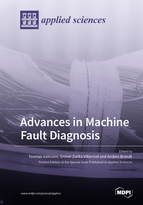Advances in Machine Fault Diagnosis
A special issue of Applied Sciences (ISSN 2076-3417). This special issue belongs to the section "Mechanical Engineering".
Deadline for manuscript submissions: closed (31 March 2021) | Viewed by 32141
Special Issue Editors
Interests: electrical machines and diagnostics of electrical machines
Special Issues, Collections and Topics in MDPI journals
Interests: vibration analysis; digital signal processing; machine diagnosis modal analysis; condition-based maintenance; machine learning
Special Issues, Collections and Topics in MDPI journals
Special Issue Information
Dear Colleagues:
Research on machine fault diagnosis (MFD) methods is receving significant attention in academia and industry due to the importance of identifying underlying causes of machine faults. The overall objective of MFD methods is to develop an effective diagnosis procedure. Recent methodological advances permit compressive MFD, providing detailed information essential for the prevention of future machine failures.
Some of the most promising approaches for the continuous advancement of fault detection and diagnosis technologies are: advanced digital signal processing, vibration-based condition monitoring, modal and operational mode analysis, neural network analysis, and machine learning.
Artificial intelligence (AI) has become one of the most transformative technological revolutions since, e.g., the invention of the steam or electric engines. Robustness, precision automated (online) learning, and the capacity to handle complex data are some of AI’s attributes that hold significant potential for MFD. In hand with the Internet of Things (IoT) and cloud computing, the emerging AI-based diagnostic methods are proving themselves to be powerful tools for the future.
The main objective of this Special Issue is to gather state-of-the-art of the research contributing recent advances in machine fault diagnosis and, hopefully, to outline future research directions in the field.
Dr. Toomas Vaimann
Prof. Dr. Grover Zurita Villarroel
Prof. Dr. Anders Brandt
Guest Editors
Manuscript Submission Information
Manuscripts should be submitted online at www.mdpi.com by registering and logging in to this website. Once you are registered, click here to go to the submission form. Manuscripts can be submitted until the deadline. All submissions that pass pre-check are peer-reviewed. Accepted papers will be published continuously in the journal (as soon as accepted) and will be listed together on the special issue website. Research articles, review articles as well as short communications are invited. For planned papers, a title and short abstract (about 100 words) can be sent to the Editorial Office for announcement on this website.
Submitted manuscripts should not have been published previously, nor be under consideration for publication elsewhere (except conference proceedings papers). All manuscripts are thoroughly refereed through a single-blind peer-review process. A guide for authors and other relevant information for submission of manuscripts is available on the Instructions for Authors page. Applied Sciences is an international peer-reviewed open access semimonthly journal published by MDPI.
Please visit the Instructions for Authors page before submitting a manuscript. The Article Processing Charge (APC) for publication in this open access journal is 2400 CHF (Swiss Francs). Submitted papers should be well formatted and use good English. Authors may use MDPI's English editing service prior to publication or during author revisions.
Keywords
- Measurement and signal processing
- Vibration based condition monitoring
- Modal and operational modal analysis
- Active vibration control
- Vibro-acoustics modelling and prediction Prognostics and health management (PHM)
- Vibration-acoustic based structural health monitoring
- Neural networks for machine diagnosis
- Artificial intelligence for machine diagnosis
- Deep learning techniques for fault detection and diagnosis
- Development of measurement systems for machine diagnosis
- Mathematical modelling for machine diagnostics








